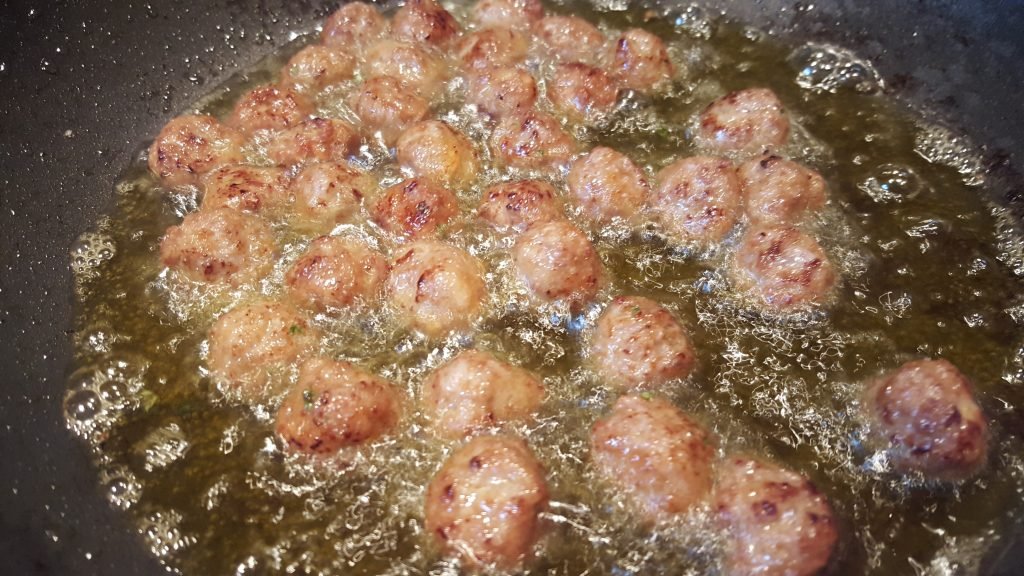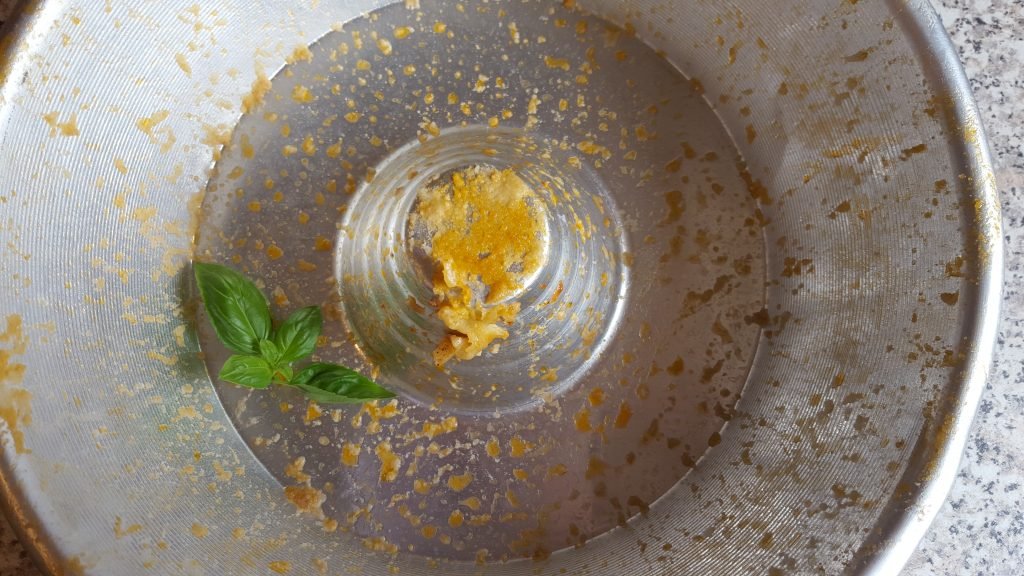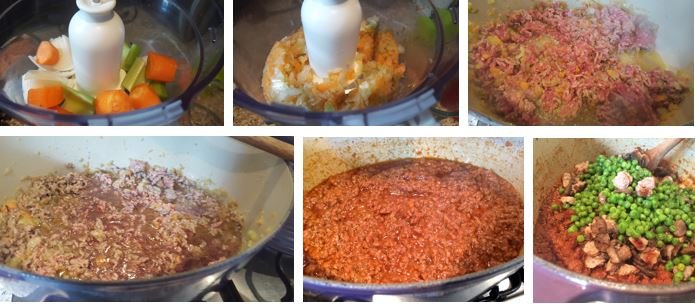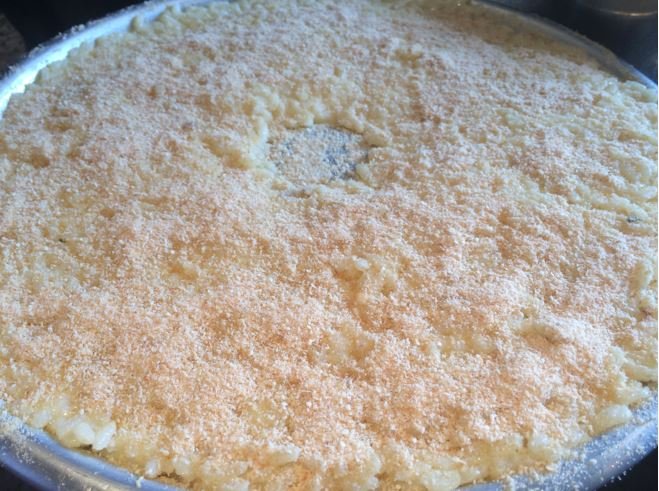
What is the typical English Sunday dish? Easy… Sunday roast!
Ask the same question to different Neapolitan families and they will come up with at least three different answers, which might include lasagna napoletana, rigatoni con ragù and ziti con ragù alla genovese.


Sartù di riso is pure delight for the palate: a timbale (a dish where the filling is wrapped in an outer layer of pasta, rice, vegetables or pastry, for example) full of goodness. A friend of mine recently saw a picture on my Instagram account and came up with what may just be the perfect line to describe this dish: rice heaven.

A luxurious filling of meat ragù slowly cooked for two hours, with the addition of mini polpettine fried in extra virgin olive oil, sautéd peas and mushrooms, as well as cervellatine (Neapolitan thin sausages similar to chipolatas), all enriched with mozzarella and parmesan, wrapped in a layer of white risotto and baked in the oven.

Needless to say: where there is a will, there is a way; volere è potere; vouloir, c’est pouvoir and all that.
I prepared sartù di riso twice over the last year and my husband regularly asks me when I’m going to make it again. And my answer is usually pretty vague, along the lines of… soon, at some point soon in the near future.

I am especially fascinated by its history. A dish that dates back to the XVIIIth century… isn’t it amazing? For those of you who love history (and I know some of you do), the historic factor is something you won’t want to miss out on. Isn’t it wonderful when food and history get together? You get the best of both worlds: you eat and you learn. Food and culture.
First clue: the name sartù is an Italianised version of the French sur tout, which means above all, referring to the rice that covers its rich filling. And what does Naples have to do with the French? Read on…
Not many of you may know that Naples used to be the capital of the Kingdom of Naples, (an ancient Italian state that existed from the XIIIth to XIXth century and included the current Italian regions of Abruzzo, Molise, Campania, Puglia, Basilicata, Calabria, as well as some areas of the current southern and eastern Lazio region).
When Naples was ruled by the Bourbon dynasty (XVIIIth century), the local cooks of the aristocratic families, known as Monzù (the Italianisation of the French word Monsieur), did their best to impress their noble masters with exquisite French-inspired dishes, using local ingredients. It was one of the first examples of great food fusion.
As if this wasn’t already interesting enough, you might be intrigued by how sartù di riso made its entrance into the Neapolitan repertoire. What I find really amusing is that rice was not even especially welcome by people living in the south… Au contraire.
There is an ancient Neapolitan song whose lyrics explain well the reputation that rice had among people when it was first imported from Spain to Naples at the end of the XIVth century.
The verses make abundantly clear the evolution rice as a food witnessed when sartù di riso was created. There is no doubt from the song about its divine goodness.
“O’ riso scaldato era na zoza – Boiled rice was rubbish
Fatt’a sartù, è tutta n’ata cosa – when it’s used to make sartù, it is something different
Ma quale pizz’e riso, qua timballo! – It is not a rice pizza nor a timbale!
Stu sartù è nu miracolo, è nu sballo. – This sartù is a miracle, a delight.
Ueuè, t’o giuro ‘ncopp’a a chi vuò tu: – Hey, I swear
è chiù meglio d’a pasta c’o rraù!” – it is even better than pasta with ragù!
Rice was basically seen as a “sciacquapanza” (a tummy cleaner), a type of food lacking in flavour and taste. It was used mainly for therapeutic purposes. Doctors from Salerno prescribed it to patients when they suffered from gastric and intestinal issues.
Things changed in 1700 during the Bourbon dynasty when the Monzù, knowing how Neapolitans had a real aversion to rice, decided to make it more tasty and added ragù, peas, mushrooms and meatballs. And the rest is history… 🙂
Ingredients for sartù di riso
Serves 8-10
For the ragu’
- 100g extra-virgin olive oil
- 1 carrot
- 1 medium-sized onion
- 1 celery stick
- 500g beef mince
- 200ml red wine
- 400ml passata
- Salt
For the mini meat balls
- 200g veal mince (can replace with beef mince)
- 30g parmesan, grated finely
- 2 regular slices of sliced bread, soaked in milk and drained well
- 1 medium-sized egg
- salt, pepper, fresh nutmeg
- a small bunch of parsley, chopped finely
For the rice
- 700g risotto carnaroli
- 1 small Montoro onion (or any bright copper-coloured onion), finely chopped
- 100g extra-virgin olive oil
- 50g salted butter
- 200ml white wine
- 1.5/2l beef stock
- 60g salted butter (in addition to the earlier 50g)
- 80g parmesan, grated finely
For the filling
- 200g mozzarella, chopped into cubes and drained
- 250g chestnut mushorooms, washed and chopped
- 150g frozen peas
- 200g cervellatine (thin Neapolitan sausages), or chipolatas
- 50g parmesan, finely grated
Extra
- A knob of butter to cook the peas
- a small onion, chopped finely to cook the mushrooms and the peas
- 2 tablespoons of extra-virgin olive oil to cook the mushrooms
Method
To make the ragù
Peel the carrots and chop roughly. Clean the celery stick and chop roughly. Peel the onion and chop roughly.
Add to a mixer and reduce them until very fine.
In a large saucepan add the oil and heat it up for a couple of minutes. Add the mix of vegetables and a pinch of salt and stir well. Add the mince and distribute it evenly across the surface with a fork.
Add the wine and on a high heat let it evaporate. Add the passata and some salt. Stir well.
Bring to a simmer and then on the lowest heat cook for 1.5/2 hours with a lid on. While waiting, you can start preparing the meatballs and the rice. That said, check the ragu’ once or twice and stir well at the bottom. When ready, set aside. The consistency will have changed from liquid to dense and thick. That is what you need.

In a bowl mix the mince and all the other ingredients together to create a compact dough. Now comes the time to get your hands sticky. Oh wait – there is a way to prevent that! Keep your hands wet or add a drop of oil to your fingers. From the dough, make little balls, the size of a hazelnut, and distribute carefully on a large plate.
In a large frying pan add 8 tablespoons of extra-virgin olive oil, warm it up and fry the mini meatballs until brown. Take them out and place them on a plate lined with kitchen paper to absorb excess oil.

Prepare the stock and make sure it is boiling hot.
Chop the onion very finely. In a large saucepan add the oil and the butter and heat slightly until the butter is melted. Add the onions, a pinch of salt and stir well. Let the onions cook for a few minutes on medium heat.
Add the rice and on medium heat make sure all grains are coated and toasted. Move them frequently with a spatula.
Add the wine and stir. On high heat let evaporate. Add two glasses of the stock, stir well, bring to a simmer and then lower the heat and cook slowly, gradually adding the rest of the stock. Don’t leave the rice alone as it dries easily and everything will turn into a proper disaster.
Carry on until the rice is very al dente and all the liquids have been absorbed. The rice should be cooked very al dente because it will be further cooked in the oven for an hour….!
In the same saucepan (with the heat off) add the butter and the parmesan and stir well until all ingredients are well incorporated. Take off the hob and set aside. You can transfer and lay the rice to a flat and large baking dish and let it cool down.


In the same frying pan, add the oil, heat slowly and add the onions. Cook gently, add the mushrooms, a pinch of salt, stir well and cook on low heat for a few minutes, until the mushrooms get smaller. There will be some liquid released in the pan. On low heat cook the mushrooms until all the liquids have been absorbed.
In a frying pan add the sausages (no need for extra fat as they will release plenty!). On medium heat cook until brown. Chop into small cubes. Set aside.
To assemble the sartù
Preheat the oven to 180° static (fan not recommended on this occasion).

Once you are done, place the dish in the fridge.
Add the peas, mushrooms and chopped chipolatas to the ragù sauce and mix well.
Take the dish out of the fridge and place about half of the rice at the bottom of the dish and on the sides, right up to the edge. I did not do it, but ideally you would cover the knob in the middle, too.
The depth of the rice layer should be about 2cm. That said, you don’t have to use a bundt-cake type of dish. A lasagna dish would work equally well. It will be slightly less impressive, but it certainly won’t change the taste!
Add half of the ragù mixture and lay it evenly on the bottom. Now distribute the mozzarella cubes evenly on top of the ragù filling. Add the rest of the ragù filling. Cover with the rest of the rice.
Distribute evenly more breadcrumbs. The original recipe calls for more butter to be added on top of the rice before the breadcrumbs. I did not do that because the rice already contains a large quantity of butter.

Place in the oven for 60 minutes. When the top is golden, take it out and let it rest for 10 minutes.
Placing a large plate on top of the baking dish, flip the dish upside down and slowly lift the dish, just like I do in the video below 😀
Tada!
